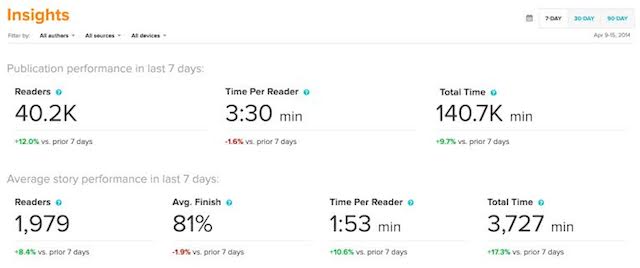There are a number of startups offering tools to help advertisers create articles, videos, and other content that can attract potential customers. (LinkedIn just announced a partnership program to work with many of those startups.) But how can companies tell if this content marketing is actually working?
That’s the problem that Contently is trying to address with its new Insights product. Since content marketers are trying to build relationships with customers, rather than just get as many eyeballs and clicks as possible for their ads, co-founder Shane Snow argued that traditional measurements like pageviews fall short.
Content marketing, Snow said, has to “be building relationships or it’s just creating content for nothing.” After all, a blog post might be getting a ton of traffic, but the pageview count doesn’t tell you whether or not people are reading a post because they like it, or because it’s a “train wreck” that everyone’s criticizing.
Vice President of Product Paul Fredrich — who, along with Snow, gave me a quick demo of the Insights product — suggested that measuring pageviews is like going to a cocktail party and “waving at people.” With Contently Insights, the company was looking to track every time you’re “stopping at a table, talking to someone, and exchanging business cards.”

So with the new product, businesses can see the total number of readers who visited their site over 7, 30, or 90 days, as well as the amount of time each reader spent on the site, and the total time spent across all readers. There’s also data on the performance of the average story over that time period — once again that will include the number of readers, the time per reader, and the total time, as well as the percent of readers who finished the post. And you can look at the stats for individual pieces of content and see how they compare to those averages.
The idea of tracking these numbers isn’t entirely new. (Chartbeat, for example, has become increasingly focused on engagement data, not just pageviews.) However, Contently is placing them front and center; it’s one thing to say that pageviews aren’t important and another to remove that number from the dashboard altogether.
In addition, Snow said Contently doesn’t just want to present numbers without context. It translates the data into fairly straightforward English (“Readers who were on your publication seemed to prefer this story”) that makes things easier to understand.
The data is also used in Contently’s existing content marketing product. Now, when a brand is connecting with a freelance writer and giving them an assignment, they can see data about how the writers’ work has performed in the past.
You can read more about the new product in Snow’s blog post from earlier this week.
Contently, by the way, is one of those content-marketing startups that’s been attracting attention from investors, raising a $9 million round earlier this year.
